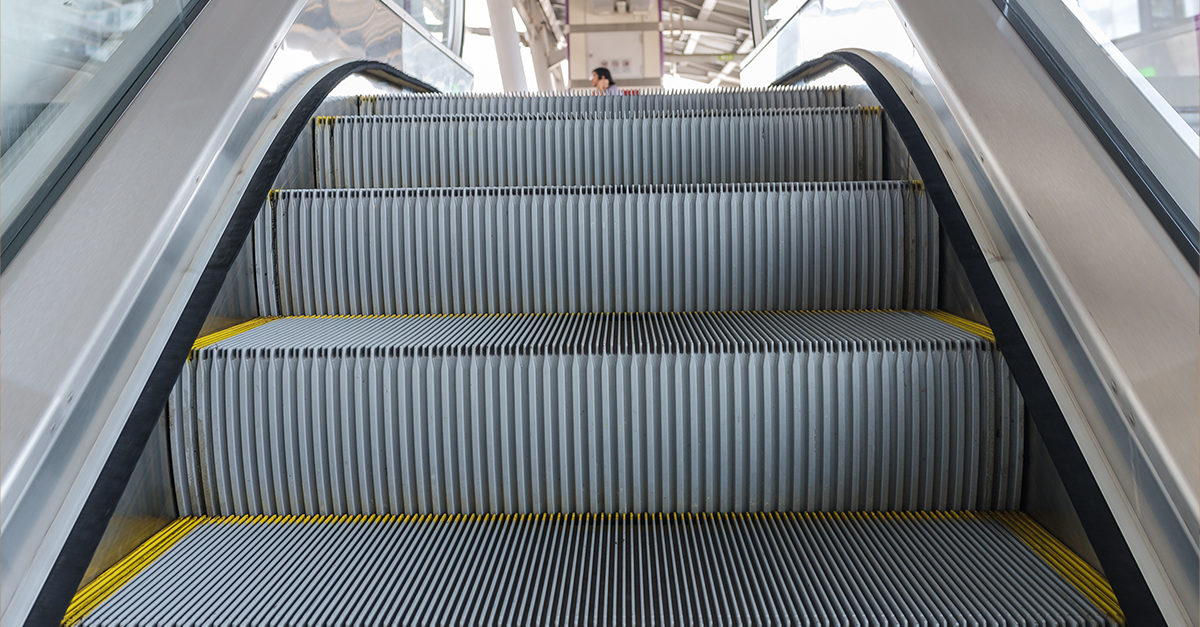An escalator is one of the first things patrons will see upon entering a hotel, airport or shopping center. No matter how clean the other areas of the building are, if the escalator is not clean people immediately can get a negative impression of the facility.
Cleaning an escalator can seem like quite a daunting task to building service contractors (BSCs) and in-house cleaning professionals. However, cleaning an escalator doesn’t have to be a challenge if there is a plan and the right equipment is used.
Challenges of escalator cleaning
When it comes to cleaning an escalator, there are several challenges to consider:
- Since escalators are not flat surfaces like floors or countertops, they require specific cleaning products and machines.
- The grooves in the tread area of the step are a magnet for impacted dirt and are hard to remove.
- Facilities that have escalators of varying widths present unique problems for cleaning staff.
- Cost vs. method of cleaning.
- Timing of cleaning and downtime for an escalator.
Developing a plan
To solve these issues, it is best to create a plan of attack.
First, develop a cleaning schedule for your escalator, the same way you would for any other area that requires cleaning.
Most facilities prefer to clean escalators during times the building is closed to visitors, or during the slowest traffic time if open 24/7.
It’s best to develop a cleaning plan immediately after installation of the escalators, so dirt does not have time to build up and get impacted in stair treads, making it harder to remove later.
But this is not always possible, so more work may be needed on heavily soiled escalators to get to the level of clean where it becomes strictly maintenance.
The facility manager and cleaning staff should decide if the cleaning will be done using the in-house team or if an outside cleaning company will be used.
Either choice is acceptable so long as the proper cleaning technique and equipment is used.
Next, schedule the frequency for the escalator to be cleaned.
Unless the escalator has never been cleaned before and is extremely dirty, the average cleaning cycle is once or twice a month.
If the escalator is in a high-traffic area, cleaning it once or twice a week may be necessary.
Always consult the manufacturer’s instructions when forming a cleaning schedule.
Selecting the right equipment
The most important piece of equipment needed when cleaning an escalator is the machine itself.
Some escalator manufacturers recommend tearing the escalator down, bringing it outdoors and using a high-pressure washer to clean it.
This is rather costly and messy, and results in inconvenient downtime of the escalator.
A better solution may be employing a specialized machine that uses a “dry” cleaning method.
In dry cleaning, the escalator-cleaning machine is positioned on the escalator as it is running so that the movement of the escalator in combination with the cleaning machine helps create agitation to remove the ground-in dirt in the tread area that regular brushes and brooms alone can miss.
In this process, the smallest amount of cleaning solution should be applied so that the escalator is not over-wetted and solution won’t get into the “grease pit” area of the escalator.
Moisture of any type that drains between the steps enters the grease pit area. There, lubrication can be lost and cause potential damage to the system.
A good cleaning solution is one that easily lifts dirt and stains off metal and dries quickly. An all-purpose cleaner is acceptable, but it’s best to check the manufacturer’s instructions to be sure.
In either case, use chemicals as sparingly as possible and allow the cleaning solution to completely dry before using an escalator-cleaning machine.
Do not use any cleaning product that will not dry completely or that will leave a film on the escalator.
Any type of cleaning machine should include a powerful vacuuming system that can pick up dust, dirt and grime easily.
Some machines are designed to remove dirt using just the movement of the escalator without any additional agitation from brushes. These machines, once they are in place, clean without any extra help.
The machines need different brush widths or “heads” depending on how wide each escalator is in multiple-escalator facilities.
Although little assistance is required while the machine is in place to clean, this method can take a long time to pick up all the dirt as the brushes are static and do not agitate on their own to assist in cleaning.
One machine that works even better to remove dirt comes equipped with agitating cylindrical brushes. Agitating brushes that rotate in the same direction allow for better loosening of dirt and help make sure as much dirt as possible is removed.
The escalator should remain on and should move in an upward motion, so that it is moving away from the cleaner.
To start, the body of the cleaner should sit firmly on the non-moving bottom landing while the brushes should lie on the first step.
The base of the machine remains anchored while the brushes are allowed to move across the step. Multiple escalator widths are more easily addressed with this type of machine, as it can be repositioned to clean narrow to wide escalators.
This type of machine does not require much additional assistance, either.
As with any cleaning equipment, it is always best to have a cleaning worker in the area in case assistance is needed.
Proper cleaning techniques
Once you have selected the cleaning machine, you need to assess how dirty the escalator is. If the escalator has never been cleaned or it has a lot of built-up dirt, expect the escalator cleaning time to be about four hours or more.
For monthly or weekly cleaning jobs, it should take only about an hour to an hour and a half to clean the entire escalator with the agitating-brush machines.
Static-brush machines are many times left to clean for four to eight hours. For simple spot removal, a low-moisture solution can be sprayed directly on the spot, but do not soak the escalator as mentioned earlier.
There are two types of brushes most commonly used in escalator cleaning — a nylon brush used for routine daily cleaning and a more aggressive tynex brush.
The tynex brush is made of nylon covered with carborundum, a material that can be more abrasive than sandpaper.
Tynex brushes are for occasional heavy-duty deep cleaning only, as overuse of these brushes can wear on the escalator over time.



